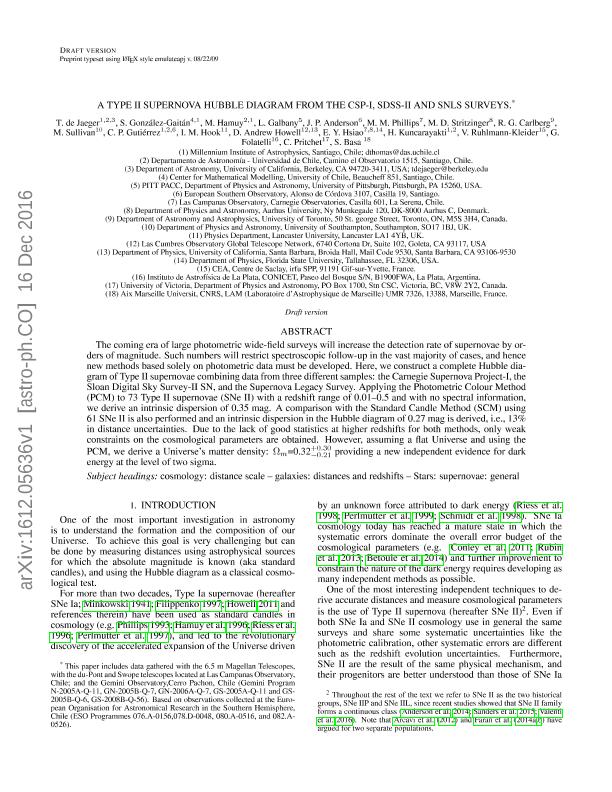Artículo
A type II supernova Hubble Diagram from the CSP-I, SDSS-II, and SNLS surveys
Jaeger, T. De; González Gaitán, S.; Hamuy, M.; Galbany, L.; Anderson, J. P.; Phillips, M. M.; Stritzinger, M. D.; Carlberg, R. G.; Sullivan, M.; Gutiérrez, C. P.; Hook, I. M.; Howell, D. Andrew; Hsiao, E. Y.; Kuncarayakti, H.; Ruhlmann Kleider, V.; Folatelli, Gaston ; Pritchet, C.; Basa, S.
; Pritchet, C.; Basa, S.
 ; Pritchet, C.; Basa, S.
; Pritchet, C.; Basa, S.
Fecha de publicación:
02/2017
Editorial:
IOP Publishing
Revista:
Astrophysical Journal
ISSN:
0004-637X
Idioma:
Inglés
Tipo de recurso:
Artículo publicado
Clasificación temática:
Resumen
The coming era of large photometric wide-field surveys will increase the detection rate of supernovae by orders of magnitude. Such numbers will restrict spectroscopic follow-up in the vast majority of cases, and hence new methods based solely on photometric data must be developed. Here, we construct a complete Hubble diagram of Type II supernovae (SNe II) combining data from three different samples: the Carnegie Supernova Project-I, the Sloan Digital Sky Survey II SN, and the Supernova Legacy Survey. Applying the Photometric Color Method (PCM) to 73 SNe II with a redshift range of 0.01-0.5 and with no spectral information, we derive an intrinsic dispersion of 0.35 mag. A comparison with the Standard Candle Method (SCM) using 61 SNe II is also performed and an intrinsic dispersion in the Hubble diagram of 0.27 mag, i.e., 13% in distance uncertainties, is derived. Due to the lack of good statistics at higher redshifts for both methods, only weak constraints on the cosmological parameters are obtained. However, assuming a flat universe and using the PCM, we derive the universes matter density: m= 0.32 m+0.30 - 0.21 providing a new independent evidence for dark energy at the level of two sigma.
Palabras clave:
Distances (Galaxias)
,
Supernovae
,
Distance Scale
,
Galaxies
,
Redshifts
Archivos asociados
Licencia
Identificadores
Colecciones
Articulos(IALP)
Articulos de INST.DE ASTROFISICA LA PLATA
Articulos de INST.DE ASTROFISICA LA PLATA
Citación
Jaeger, T. De; González Gaitán, S.; Hamuy, M.; Galbany, L.; Anderson, J. P.; et al.; A type II supernova Hubble Diagram from the CSP-I, SDSS-II, and SNLS surveys; IOP Publishing; Astrophysical Journal; 835; 2; 2-2017
Compartir
Altmétricas



